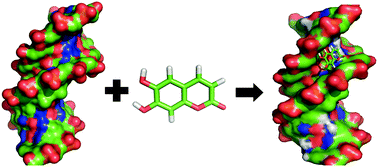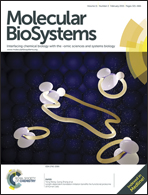Multi-spectroscopic and molecular modelling studies on the interaction of esculetin with calf thymus DNA†
Abstract
Understanding the interaction of small molecules with DNA has become an active research area at the interface between chemistry, molecular biology and medicine. Plant derived polyphenols possess diverse biological and pharmacological properties. Esculetin is a coumarin derivative polyphenolic compound having diverse pharmacological and therapeutic properties. However, its mode of interaction with DNA is still not well understood. In the present study, we have attempted to determine the mode of binding of esculetin with calf thymus DNA (Ct-DNA) through various biophysical techniques. Analysis of UV-visible absorbance spectra and fluorescence spectra indicates the formation of a complex between esculetin and Ct-DNA. The binding constant was found to be 1.87 × 104 M−1. Thermodynamic parameters ΔG, ΔH, and ΔS at different temperatures indicated that hydrophobic interactions and hydrogen bonding played major roles in the binding process. Several other experiments such as iodide induced quenching and competitive displacement studies with ethidium bromide, acridine orange and Hoechst 33258 suggested that esculetin possibly binds to the minor groove of the Ct-DNA. The strong dependence on ionic strength in controlling the binding of esculetin with Ct-DNA confirms the possibility of electrostatic interaction. These observations were further supported by DNA melting studies, viscosity measurements, CD spectral analysis and in silico molecular docking.


 Please wait while we load your content...
Please wait while we load your content...